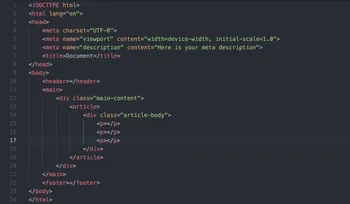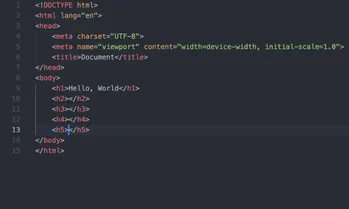Meta descriptions are an essential part of search engine optimization (SEO) that can help increase clickthrough rates and conversions. In this article, we will explore what meta descriptions are, why they're important for SEO, best practices for writing them, common mistakes to avoid, examples of great meta descriptions, tools for writing and testing them, and how to measure their success.
Understanding the Basics
What is a meta description?
A meta description is an HTML attribute that provides a summary of a webpage's content. It appears in search engine results pages (SERPs) below the page title and URL, and it helps users understand what the page is about before clicking on it. The meta description should be a concise and accurate summary of the page's content, including relevant keywords that match the user's search query.
Where does the meta description appear?
The meta description appears in the head section of an HTML document, which contains metadata and other information about the webpage. While meta descriptions are not visible to users on the web page itself, they are displayed in SERPs when a user searches for a keyword or phrase related to the page's content.
Why are meta descriptions important for SEO?
Meta descriptions play an essential role in SEO because they can influence clickthrough rates and conversions. When a user sees a compelling meta description that matches their search query, they are more likely to click on the result and visit the webpage. This can lead to higher rankings in SERPs, increased traffic, and ultimately, more conversions.
Best Practices for Writing Meta Descriptions
Keep it short and sweet (150-160 characters)
Meta descriptions should be concise and to the point, ideally between 150-160 characters in length. This is because search engines typically truncate meta descriptions that exceed this character limit, making them less effective at conveying the page's content. Keeping the meta description short and sweet also helps ensure that it is easily readable and understandable to users.
Make it compelling and relevant to the content on the page
The meta description should be engaging and relevant to the content on the page. It should provide a clear value proposition that entices users to click on the result and visit the webpage. Using action-oriented language, such as "learn more," "discover how," or "find out why," can help make the meta description more compelling and increase clickthrough rates.
Include a clear call-to-action
Including a clear call-to-action (CTA) in the meta description can help encourage users to take action on the webpage. For example, using a CTA like "sign up now," "book your appointment today,"or "get started with our free trial" can help guide users toward a specific goal or conversion.
Use unique meta descriptions for each page
Using unique meta descriptions for each page is essential for SEO because it helps search engines understand the content of each page and its relevance to user queries. Duplicate meta descriptions can lead to confusion and lower rankings in SERPs, so it's important to create a unique meta description for each page on your website.
Avoid using double quotes or special characters
Using double quotes or special characters in the meta description can cause issues with how search engines display the result in SERPs. For example, if a double quote is used, search engines may truncate the meta description at that point, making it less effective at conveying the page's content. It's best to avoid using these types of characters altogether and stick to plain text.
Include your target keyword(s) naturally
Including your target keyword(s) in the meta description can help improve its relevance to user queries and increase clickthrough rates. However, it's important to include them naturally and avoid keyword stuffing or over-optimization. Using keywords in a way that sounds forced or unnatural can actually harm your rankings and decrease clickthrough rates.
Common Mistakes to Avoid
Writing too long or too short of a description
Writing a meta description that is too long or too short can harm its effectiveness in SERPs. If it's too long, search engines may truncate it, making it less readable and understandable. If it's too short, it may not provide enough information to entice users to click on the result. It's important to stick to the recommended character limit of 150-160 characters.
Using the same meta description on multiple pages
Using the same meta description on multiple pages can lead to confusion and lower rankings in SERPs. Search engines may view this as duplicate content, which can harm your website's overall SEO performance. It's important to create unique meta descriptions for each page on your website.
Not including any keywords
Not including any keywords in the meta description can make it less relevant to user queries and decrease clickthrough rates. Including relevant keywords naturally and contextually can help improve its relevance and increase clickthrough rates.
Making false or misleading claims in the description
Making false or misleading claims in the meta description can harm your website's reputation and trustworthiness. It's important to be truthful and transparent about the content on the page and avoid making exaggerated or unrealistic claims that could mislead users.
Ignoring character limits and truncation
Ignoring character limits and truncation can result in a meta description that is cut off or difficult to read in SERPs. It's important to stick to the recommended character limit of 150-160 characters and avoid using double quotes or special characters that could cause issues with truncation.
Examples of Great Meta Descriptions
Analyze examples from top-ranking websites
Analyzing examples from top-ranking websites can provide valuable insights into what works best in meta descriptions. For example, a search for "best running shoes" returns results with compelling and relevant meta descriptions that include target keywords naturally and make clear value propositions to users.
Identify what makes them effective
Identifying what makes these meta descriptions effective can help inform your own meta description writing strategy. For example, using action-oriented language, including target keywords naturally, and making clear value propositions are all key elements of effective meta descriptions.
Tools for Writing and Testing Meta Descriptions
Google's meta description tool
Google offers a free meta description tool that can help you test and optimize your meta descriptions for SEO. Simply enter your meta description into the tool, and it will provide feedback on its length, relevance, and keyword usage.
Yoast SEO plugin for WordPress
The Yoast SEO plugin for WordPress is a popular tool for writing and testing meta descriptions. It offers real-time feedback on meta description length, keyword usage, and readability, making it easy to optimize your meta descriptions for SEO.
Other third-party tools and resources
There are many other third-party tools and resources available for writing and testing meta descriptions. For example, SEMrush offers a meta tag analyzer that can help you analyze the effectiveness of your meta descriptions and identify areas for improvement.
Measuring Success: Analyzing Clickthrough Rates and Conversions
Using Google Analytics to track clickthrough rates
Using Google Analytics to track clickthrough rates is an essential part of measuring the success of your meta descriptions. By analyzing clickthrough rates over time, you can identify which meta descriptions are most effective at driving traffic and conversions.
Setting up conversion tracking in Google Search Console
Setting up conversion tracking in Google Search Console can help you measure the impact of your meta descriptions on user behavior. For example, you can track how many users who click on a result with a particular meta description go on to complete a desired action, such as making a purchase or filling out a form.
Testing and optimizing meta descriptions for better results
Testing and optimizing your meta descriptions is essential for improving their effectiveness over time. By experimenting with different approaches, such as using different keywords or CTAs, you can identify what works best for your website and audience.
FAQ Section
Q: What is a meta description?
A: A meta description is an HTML attribute that provides a summary of a webpage's content. It appears in search engine results pages (SERPs) below the page title and URL, and it helps users understand what the page is about before clicking on it.
Q: Why are meta descriptions important for SEO?
A: Meta descriptions play an essential role in SEO because they can influence clickthrough rates and conversions. When a user sees a compelling meta description that matches their search query, they are more likely to click on the result and visit the webpage. This can lead to higher rankings in SERPs, increased traffic, and ultimately, more conversions.
Q: How long should a meta description be?
A: A meta description should ideally be between 150-160 characters in length. This is because search engines typically truncate meta descriptions that exceed this character limit, making them less effective at conveying the page's content.
Q: Should I include keywords in my meta description?
A: Yes, it's important to include relevant keywords naturally and contextually in your meta description. However, avoid keyword stuffing or over-optimization as this can harm your rankings and decrease clickthrough rates.
Q: Can I use the same meta description on multiple pages?
A: No, it's important to create unique meta descriptions for each page on your website. Using the same meta description on multiple pages can lead to confusion and lower rankings in SERPs.
Q: How do I measure the success of my meta descriptions?
A: You can measure the success of your meta descriptions by using tools like Google Analytics to track clickthrough rates, setting up conversion tracking in Google Search Console, and testing and optimizing your meta descriptions over time. By analyzing user behavior and experimenting with different approaches, you can identify what works best for your website and audience.
Q: Are there any tools that can help me write and test my meta descriptions?
A: Yes, there are many tools available to help you write and test your meta descriptions. For example, Google's meta description tool, the Yoast SEO plugin for WordPress, and SEMrush's meta tag analyzer are all popular options that can provide feedback on your meta descriptions' length, relevance, and keyword usage.
Q: What should I avoid when writing meta descriptions?
A: When writing meta descriptions, it's important to avoid common mistakes such as making false or misleading claims, using double quotes or special characters that could cause issues with truncation, ignoring character limits and truncation, and using the same meta description on multiple pages. Instead, focus on creating unique, compelling, and relevant meta descriptions that provide clear value propositions to users.
Conclusion
Meta descriptions are an essential part of SEO that can help increase clickthrough rates and conversions. By following best practices for writing them, avoiding common mistakes, analyzing examples from top-ranking websites, using tools to write and test them, and measuring their success through analytics, you can create effective meta descriptions that drive results for your website. Remember to always stay up-to-date with the latest SEO trends and best practices, and continue experimenting and optimizing over time to achieve the best possible results.




